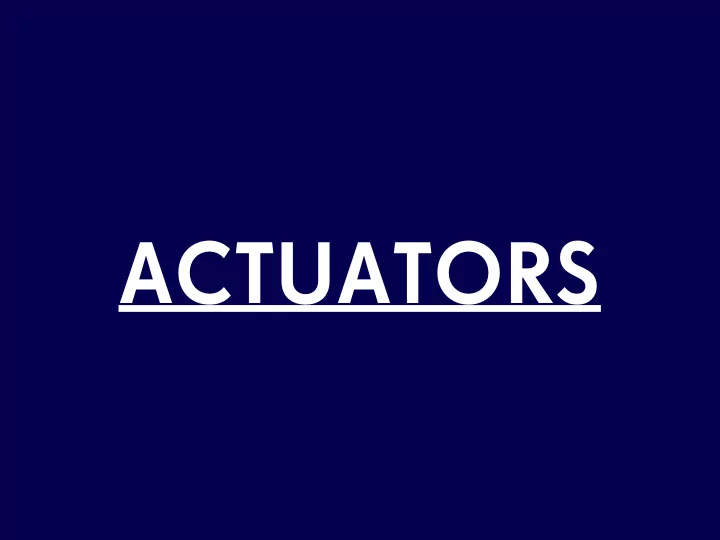

ACTUATORS
SERVOS
RED => POWER BLACK => GROUND YELLOW => INPUT Input accepts a range from 0 to 180.
CONTROL SERVO WITH ANALOG INPUT
H-BRIDGE
The L293/SN754410 is a very basic H-bridge. It has two bridges, one on the left side of the chip and one on the right, and can control 2 motors. It can drive up to 1 amp of current, and operate between 4.5V and 36V.
Pin 1 (1,2EN) enables and disables our motor whether it is give HIGH or LOW Pin 2 (1A) is a logic pin for our motor (input is either HIGH or LOW) Pin 3 (1Y) is for one of the motor terminals Pin 4-5 are for ground Pin 6 (2Y) is for the other motor terminal Pin 7 (2A) is a logic pin for our motor (input is either HIGH or LOW) Pin 8 (VCC2) is the power supply for our motor, this should be given the rated voltage of your motor Pin 9-11 are unconnected as you are only using one motor in this lab Pin 12-13 are for ground Pin 14-15 are unconnected Pin 16 (VCC1) is connected to 5V
CONTROLLING A MOTOR WITH A H-BRIDGE
CONTROLLING A MOTOR WITH A H-BRIDGE
STEPPER MOTORS
Stepper motors are motors that have multiple coils in them, so that they can be moved in small increments or steps. They come in two types, unipolar or bipolar, meaning that they have either one main power connection or two. Both kinds can be controlled a H-bridge.
To control a stepper, apply voltage to each of the coils in a specific sequence.
To control a stepper, apply voltage to each of the coils in a specific sequence. But we won’t have to, because there is a handy Arduino library.
THE INSIDE OF A STEPPER MOTOR
CONTROLLING A STEPPER MOTOR WITH A H-BRIDGE motor power supply
CONTROLLING A STEPPER MOTOR WITH A H-BRIDGE
TRANSISTORS
When using electro-mechanical devices, we'll be dealing with currents that are larger than Arduino's IO pins can handle. A transistor is an electronic component that can help to amplify small electric currents (about 25mA) that the Arduino can provide.
There are two standard types of transistors, NPN and PNP. In this class we'll use NPN transistors to sink current from a positive voltage supply.
Transistors usually have three leads: - base (B) - collector (C) - emitter (E) The rule is that small base current controls a larger collector current, so we can control high-current devices connected to collector by switching base current with the Arduino.
2N2222 Transistor - base (B) - collector (C) - emitter (E)
A B C D E F G H I J 1 1 5 5 10 10 15 15 20 20 25 25 30 30 A B C D E F G H I J RESET ICSP2 TRANSISTOR LED AREF RX TX L GND 13 IOREF 12 RESET Arduino 11 3V3 10 5V 9 GND 8 CONTROL POWER GND TM DIGITAL (PWM= VIN 7 6 2N2222 A0 5 A1 4 A2 3 ANALOG IN A3 ) 2 A4 TX0 1 ICSP ON 1 A5 RX0 0
CONTROLLING HIGH-CURRENT LOADS The TIP-120 Transistor can handle loads up to 5 Amps, far more than you can drive with a 2N2222 (600mA) or directly from an output pin.
CONTROLLING to power supply HIGH-CURRENT LOADS
“BLINK” A MOTOR
RELAYS
Relay is an electrical switch operated by an electromagnet. We can use a transistor to control the flow of current through the coil of relay's magnet, switching a pair of contacts on and off. Since relay contacts make a mechanical connection, they can be used to connect different types of signals (for example: AC voltage, audio, video) just like connecting and disconnecting a pair of wires.
Recommend
More recommend